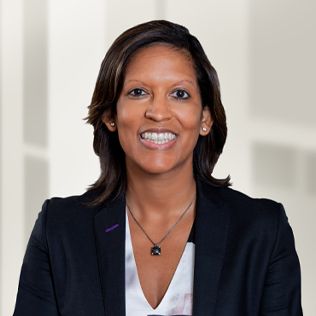Taking steps to improve diversity in clinical trials
Research studies often fail to include enough participants from minority groups. Jenn Higgins of Guardant Health talks about getting a diverse mix for the ECLIPSE trial.
Healthcare leaders are increasingly focused on improving the diversity of clinical trials, and it’s an area where companies and researchers need to do better.
Researchers and organizations need to take thoughtful steps to ensure appropriate diversity in clinical trials, says Jenn Higgins of Guardant Health.

It’s important to give consideration to diversity in trials, and healthcare companies, universities and researchers must also consider factors that could be hampering efforts to find a greater mix of participants, says Jenn Higgins, senior vice president of global public affairs at Guardant Health.
“I think there's a need and interest to make sure that when you do a clinical trial, that it's representative of the overall population. But that's not the easiest thing to do,” Higgins tells Chief Healthcare Executive®.
Lack of awareness of clinical trials can hurt diversity efforts, along with a lack of access, she says. For some members of disadvantaged communities, they may have difficulty with transportation or be busy working during the times they’d need to be present for trials. She also points out that some members of minority groups have misgivings about the medical establishment.
“If it's easy for me to be a part of a trial, I'm more inclined to do it,” Higgins says. “If you make it hard and you have this stigma on top of it, I'm very unlikely to be an active participant in a clinical trial.”
Guardant enrolled 20,000 participants for research of its Shield blood test designed to detect colorectal cancer. Guardant’s trial was dubbed ECLIPSE (”Evaluation of ctDNA LUNAR Assay In an Average Patient Screening Episode”). The study found the tests demonstrated 83% sensitivity for detecting colorectal cancer, according to findings published last month in the New England Journal of Medicine.
The Guardant study managed to enlist Black and Hispanic participants that reflected the size of their populations, Higgins notes. She says reaching diversity targets for Black and Hispanic patients “was an important goal.”
Generally, participation among Black and Hispanic Americans in clinical trials lags their representation in the U.S. population at large, according to data on drug trials from the Food and Drug Administration. The FDA data show Black participants accounted for 8% of drug trials in 2020, while they represent 13.6% of the population. Similarly, while roughly 1 in 5 Americans are Hispanic or Latino, only 11% of trial participants are Hispanic or Latino.
“There's a huge disparity in clinical trials, in terms of who are represented populations … particularly in the cancer space,” Higgins says. “There has been sort of consistent under-representation, particularly in black and Hispanic communities, even though their burden of cancer incidence is frankly much higher.”
Black patients have higher mortality rates for prostate, stomach and uterine cancers, according to the latest annual report from the American Cancer Society. (The findings were published in CA: A Cancer Journal for Clinicians.)
During Guardant’s ECLIPSE trial, the company saw the importance of going to “non-traditional settings,” including community centers and faith-based organizations, Higgins says.
“You can't just assume that because people are coming into the healthcare system that they're naturally going to consider enrolling in a trial,” Higgins says. “And so you have to kind of meet people where they are.”
Researchers and organizations must make sure that “you're capturing and educating people in a community about your trial and whether they're able to enroll or not, and then helping to facilitate that enrollment,” she says. Higgins stressed the importance of working with trusted community leaders to build credibility.
In addition to reaching out into the community, providers should also make sure physicians are aware of clinical trials in their area.
“Physicians are quite busy so it's probably not at the top of their list to keep track of every trial that's ongoing, to make sure that patients are aware of them,” Higgins says.
Researchers shouldn’t underestimate transportation as a barrier to participation in clinical trials, especially in areas with limited public transportation. Guardant partnered with ride-sharing services to help transport patients, Higgins says.
Researchers need to enlist a varied mix of participants to effectively evaluate therapies on different racial and ethnic groups, she notes.
“Many of the therapies and treatments that are being developed have different impacts on those populations,” Higgins says. “So it's important from a research standpoint and from an efficacy standpoint to make sure that we're identifying those populations.”
Healthcare leaders note that diversity is needed in research trials because certain racial groups may respond differently to treatments. Nakela L. Cook, executive director of the Patient-Centered Outcomes Research Institute, said the lack of diversity leads to less effective research during a discussion at the American Heart Association Scientific Sessions in Philadelphia last November.
“If these populations are not fully represented, it will affect the applicability of the findings," Cook said.
As researchers and organizations look to add diversity to clinical trials, they need to consider providing information in languages beyond English, Higgins notes. She noted neighborhoods in Los Angeles where the primary language is Korean.
“One of the things that we recognize is that, frankly, we have to make sure that we're offering translation services, we're offering services that are in different languages when we're trying to communicate about a trial,” Higgins says. “Because one of the big pieces of this too is that we can't make an assumption, especially in certain communities.”
Telehealth faces a looming deadline in Washington | Healthy Bottom Line podcast
February 12th 2025Once again, the clock is ticking on waivers for telemedicine and hospital-at-home programs. Kyle Zebley of the American Telemedicine Association talks about the push on Congress and the White House.